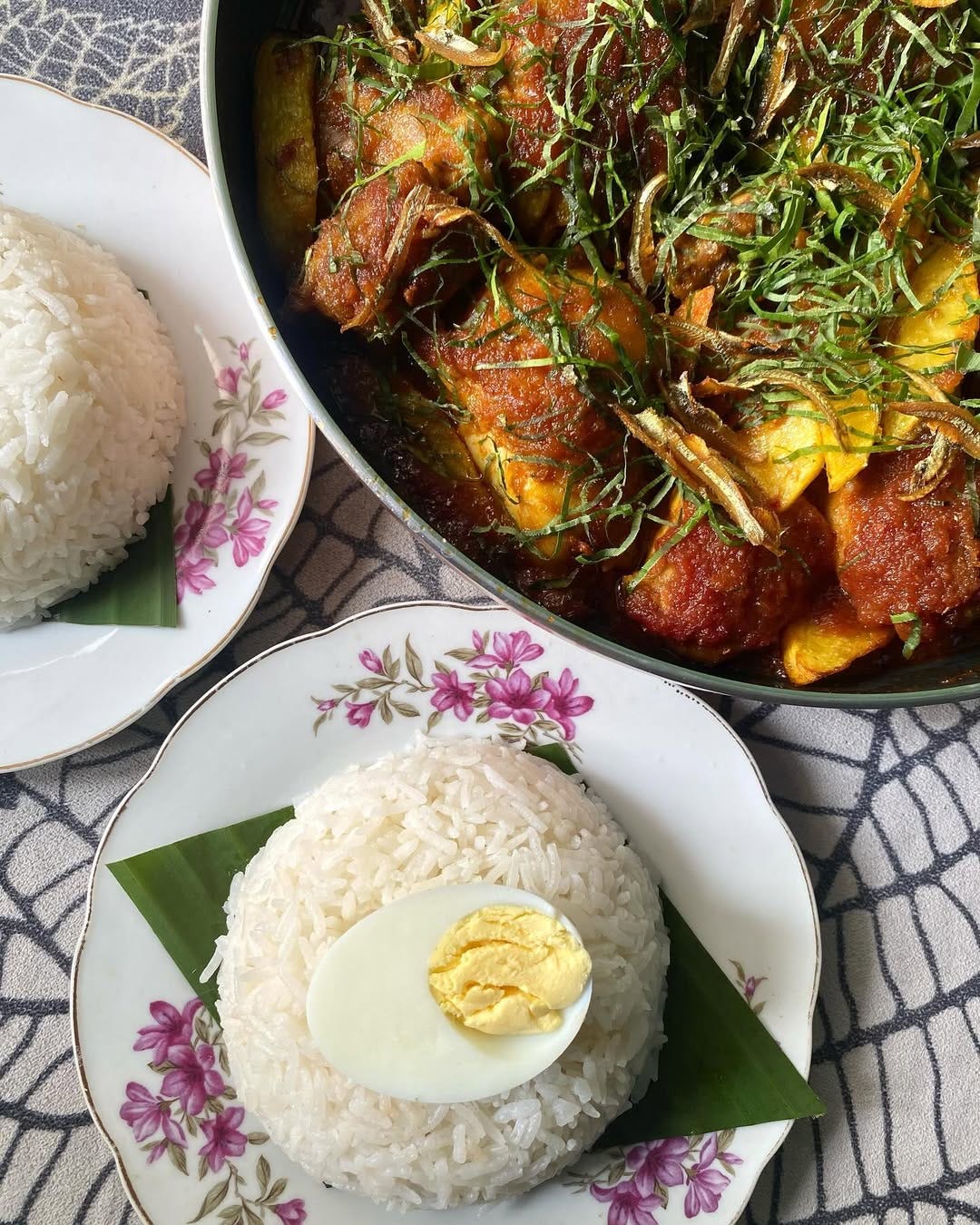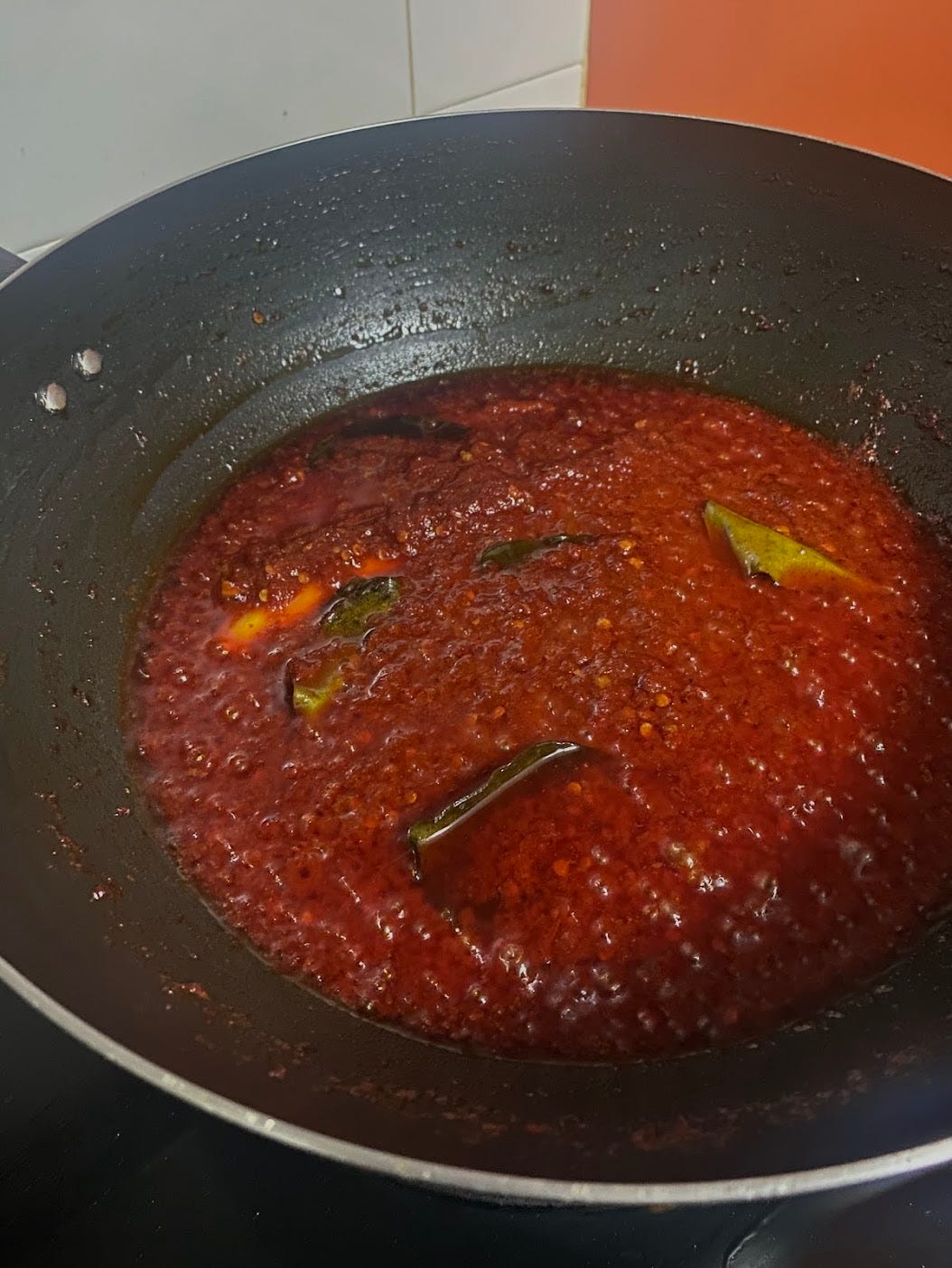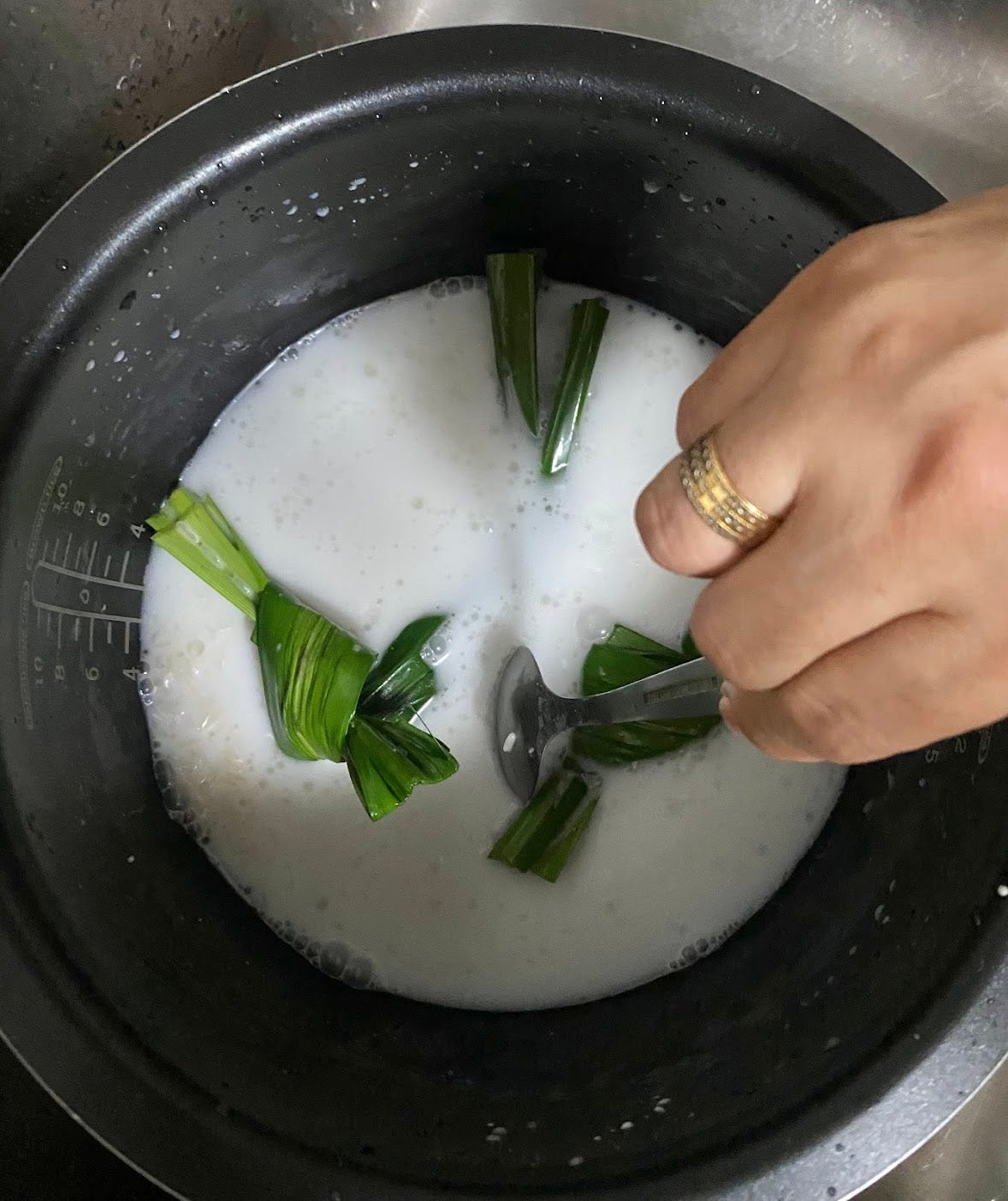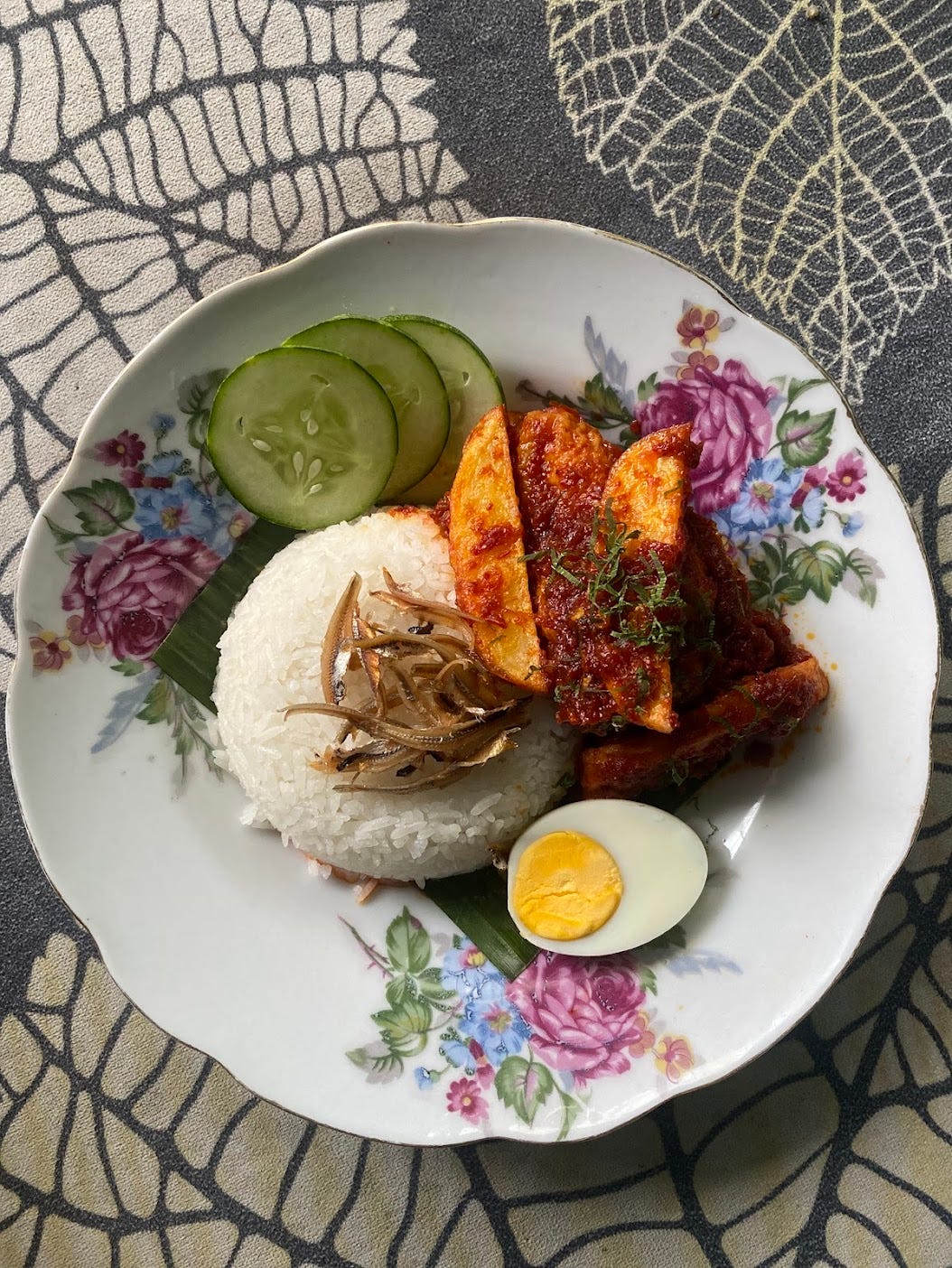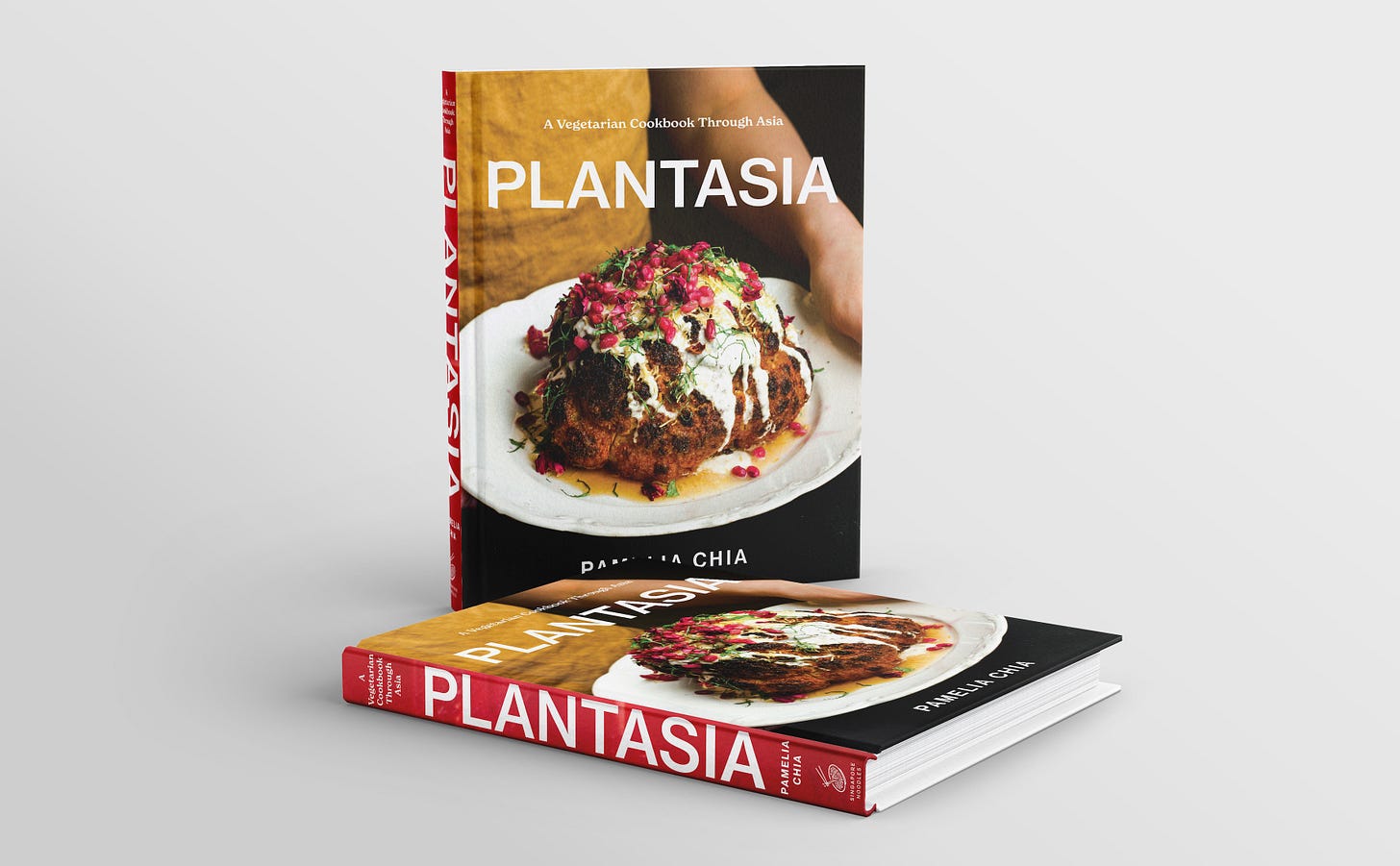✨ Welcome to Singapore Noodles, a newsletter dedicated to celebrating Asian culinary traditions and food cultures. Every Monday, you’ll be receiving a tasty mix of food history, stories, and recipes straight in your inbox. This week, we have Suria Insyirah Suparja sharing her family’s story and recipe for sambal tumis ayam goreng, a one-pot chicken dish inspired by the flavours of nasi lemak.
This newsletter is 100% reader-funded — your paid subscription directly supports the writing and research, pays guest contributors, and gives you access to all content and recipes. As the newsletter grows, I’m eager to expand our community of guest contributors who will share their expertise and food stories with you. Thank you for being here and enjoy this week’s newsletter! - Pamelia✨
Nasi Lemak-Inspired Sambal Tumis Ayam Goreng
Words and Photographs by Suria Insyirah Suparja
Both my late grandparents were born in Java, Indonesia. They lived in what Singaporeans would call a kampung, or a village, where people mostly foraged for cooking ingredients. The exact period when they migrated to Singapore is unclear, but it must have been between the late 1940s to early 1950s. My mother and her 12 siblings grew up living in a flat — government housing built to replace the kampungs where many Singaporeans previously lived. This move from kampung to urbanised, high-rise living marked a shift in the way many families cooked, including mine. Banana leaves, traditionally harvested from the wild or home gardens to serve as natural food packaging and decorative plate-liners, were now purchased from the pasar (wet market) or the newly burgeoning supermarkets, or simply treated as redundant. Coconut milk, or santan, once squeezed from mature flesh scraped from whole coconuts, could now be conveniently bought in tin cans or cartons.
My mother, as the youngest of the family with working siblings, took on the domestic role of caring for her elderly parents and cooking. Her recipes came from my grandmother, an accomplished cook, and these later fed us — my mother’s own family. As our family’s breadwinner, she worked tirelessly, often for long hours. During her free time, I would join her in the kitchen to prepare meals. Unlike other mothers who might swat their children away from the kitchen, my mother was always welcoming of me, and that, I think, made all the difference in the way I embraced food and cooking. Such moments were priceless — the warmth of our small kitchen filled with the comforting aromas of home-cooked food. Time spent with my mother was limited, making each second in the kitchen meaningful regardless of what we cooked. Even when money was tight, something as simple as fried egg, kicap manis, and rice brought us nourishment and comfort.
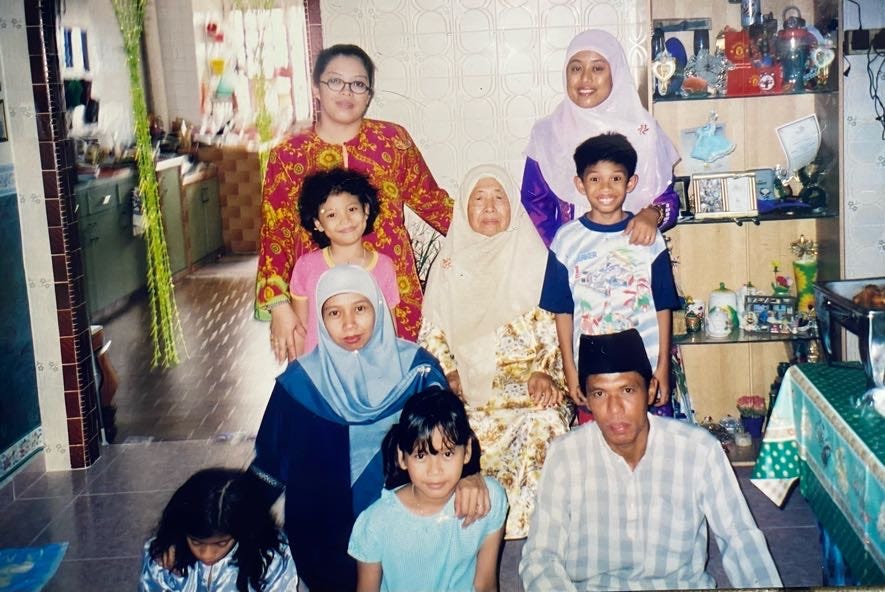
Even though she was a working woman, my mother loved hosting birthday parties and festive gatherings, going all-out with an impressive array of dishes prepared in substantial quantities. During Hari Raya, for instance, she would rise before anyone else in the family to perform dawn prayers and head to the market to select the freshest ingredients. I would be waiting to join her by the time she returned. No expense was spared when preparing a feast: her sambal goreng pengantin, for example, was a complex dish involving not just deep-frying tofu, tempeh and shrimp, but also carefully preparing beef lungs, and meticulously slicing and blanching long beans. But the one dish that she reserved for our family alone and never made for big gatherings was her nasi lemak.
Nasi lemak holds a special place in the hearts of many locals, particularly those who lived by the coast, where coconuts and fish were abundant. Rice is cooked with coconut milk until each creamy grain glistens, and paired with eggs, fried turmeric-scented fish or chicken, dried small anchovies known as ikan bilis, sambal, and cooling slices of cucumber. But to my mother, the heart of the dish has always been the sambal tumis, a sweet chilli condiment made by patiently stirring the rempah until it reached the stage of pecah minyak (when the oil from the rempah splits) and darkened to a rich, dark crimson.
Occasionally, we would have nasi lemak for breakfast at a warung after grocery shopping at the nearby market, but it tasted very different. Their sambal was more savoury with belacan, while my mother’s sambal didn’t include this fermented shrimp paste and was sweeter. My mother’s version also used boiled eggs instead of fried, which in my opinion pairs better with sambal. She also added a little turmeric leaf, not typical of nasi lemak recipes, which cut the spiciness of the dish and added freshness.
When I was in primary school, our family moved to the Indian coastal state of Kerala for my father’s work. There, it was difficult to find food that we were familiar with, such as nasi lemak, or even halal options. At school in Singapore, we had a canteen featuring various stalls to order from. However, in my new school, there was only a non-halal pop-up. This limited our choices, making home-cooked food almost a lifeline for us. Coconuts and rice are abundant in Kerala, so nasi lemak became a dish that my mother cooked frequently. Once, at a local market, we were horrified to see the chicken being slaughtered alive and feathers plucked in front of my eyes. Following that event, we would go to KFC in a tuk tuk (auto-rickshaw) and serve their fried chicken with my mother’s nasi lemak. Amidst the changes in our lives, nasi lemak reminded me of home and moments of enjoying it as a family in Kerala has become a cherished memory for me.
Upon returning to Singapore, I struggled to keep up in school because the syllabus was completely different. I had to relearn everything, which proved challenging. But as one Malay saying goes, flowers bloom in their own time and so I learnt to honour my own timing and have patience with myself. The silver lining of my experience of living abroad was that it showed me how important cooking traditions are in anchoring oneself to one’s community, and I soon developed a real passion for Malay cooking and a desire to preserve my mother’s culinary expertise by cooking her recipes.
The journey has not always been easy. The Malay phrase air tangan ibu — “water from a mother’s hands” — explains why replicating your mother’s food can be so challenging, even when you have spent years by her side observing silently. So much of a person’s air tangan infuses the food that they cook — their soul, their personal history with cooking, their own cultivated instincts as a cook. My mother’s generation didn’t write down their recipes, not because measurements were irrelevant, but because all their knowledge resided in their hands and hearts. I learnt that, just as my mother developed her own way of doing things, I had to do the same.
Leaning upon my mother’s coconut rice and sambal recipes, my own version of nasi lemak reinterprets the dish as an almost one-pot meal. Traditionally, the coconut rice is accompanied by fried chicken, sambal, and fried anchovies. I have combined these three elements in a single dish: fried chicken smothered and simmered in sambal, topped with fried anchovies and my mother’s touch of turmeric leaves. The incorporation of fried potatoes adds a satisfying element, inspired by my mom’s ayam masak merah. My mother has tasted the dish and loved it; she enjoys when I cook, especially when the food that I cook draws inspiration from her recipes. There is a beautiful expression — makan sepinggan, kenyang bersama (“when we eat from one plate, everyone feels full together”) — which emphasises the importance of communal meals in Malay food culture. This is a wonderful dish to share with family and friends, and I hope that it gives you the same sense of nourishment, comfort, and big-hearted generosity that it evokes for me.
Suria Insyirah Suparja is an aspiring culinary school student who runs Dapur Cahaya, a community page dedicated to celebrating traditional Malay cuisine. Through her platform, she aims to rediscover her roots and share the rich culinary heritage of her culture.
🎄✨ Christmas is around the corner! To celebrate, I’m offering a one-for-one deal on my cookbook Plantasia and 20% off all annual subscriptions leading up to the holidays.
Nasi Lemak-Inspired Sambal Tumis Ayam Goreng
Makes 5 to 6 servings
Takes 1 hour




